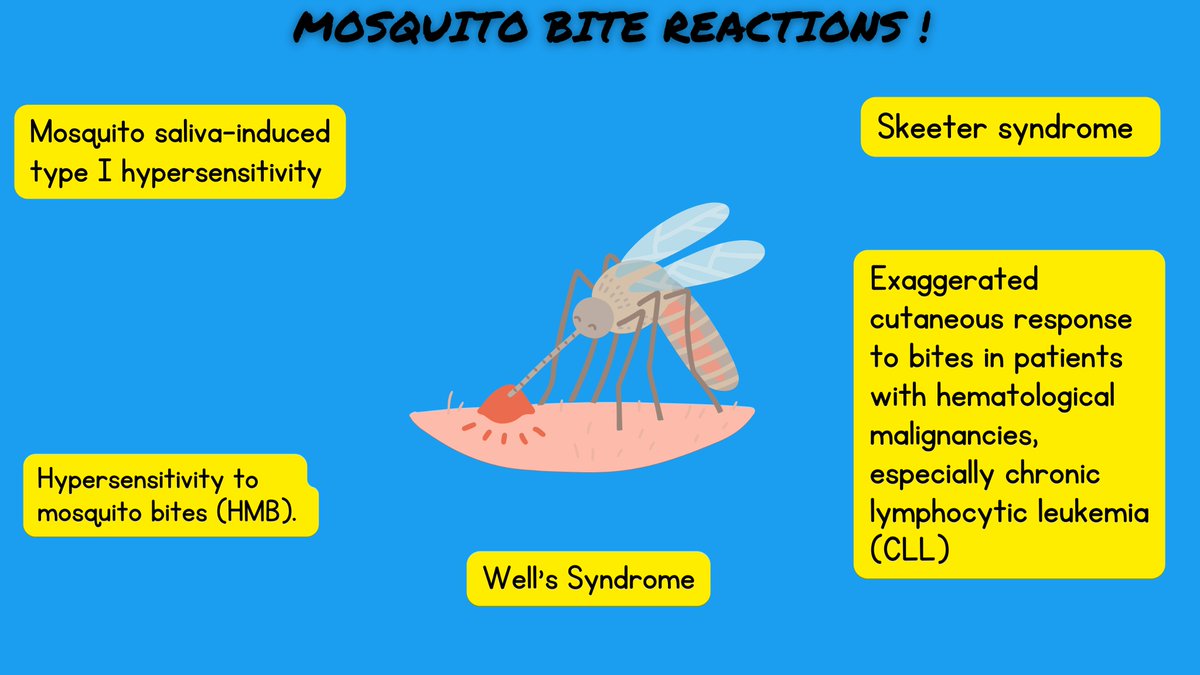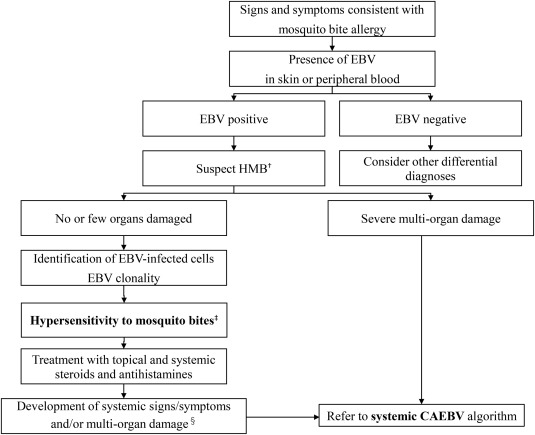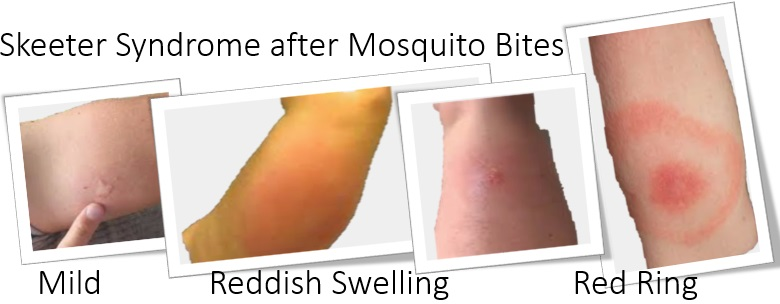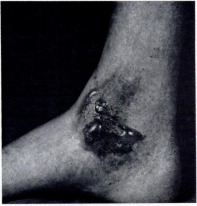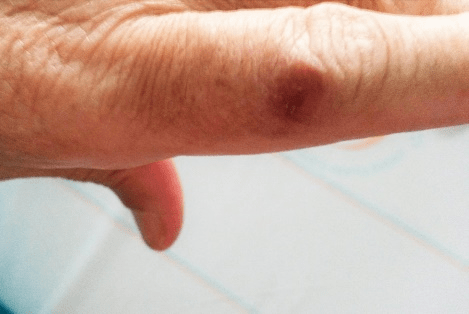1/17
“The skin truly can be a mirror of what’s going on inside the body “
During a #CPSbootcamp conversation we started discussing mosquito bites. How they can be a signal to internal disease ? Let& #39;s explore @deboracloureiro @KirtanPatolia @CPSolvers @seymss15
#MedTwitter
“The skin truly can be a mirror of what’s going on inside the body “
During a #CPSbootcamp conversation we started discussing mosquito bites. How they can be a signal to internal disease ? Let& #39;s explore @deboracloureiro @KirtanPatolia @CPSolvers @seymss15
#MedTwitter
2/17
Mosquito saliva-induced type I hypersensitivity induces a strong itch sensation. This is a process of vasodilation + inflammation
First https://abs.twimg.com/emoji/v2/... draggable="false" alt="➡️" title="Pijl naar rechts" aria-label="Emoji: Pijl naar rechts"> immediate wheal and flare reaction develops within 15–30 min
https://abs.twimg.com/emoji/v2/... draggable="false" alt="➡️" title="Pijl naar rechts" aria-label="Emoji: Pijl naar rechts"> immediate wheal and flare reaction develops within 15–30 min https://abs.twimg.com/emoji/v2/... draggable="false" alt="➡️" title="Pijl naar rechts" aria-label="Emoji: Pijl naar rechts"> delayed pruritic induration arises within a day or 2 which resolves
https://abs.twimg.com/emoji/v2/... draggable="false" alt="➡️" title="Pijl naar rechts" aria-label="Emoji: Pijl naar rechts"> delayed pruritic induration arises within a day or 2 which resolves
Mosquito saliva-induced type I hypersensitivity induces a strong itch sensation. This is a process of vasodilation + inflammation
First
3/17
Hypersensitivity to mosquito bites (HMB):
HMB or severe mosquito bite allergy (SMBA) is a cutaneous form of chronic active Epstein–Barr virus disease (CAEBV).
HMB belongs to a category of Epstein–Barr virus (EBV)-associated NK cell lymphoproliferative disorders (LPD).
Hypersensitivity to mosquito bites (HMB):
HMB or severe mosquito bite allergy (SMBA) is a cutaneous form of chronic active Epstein–Barr virus disease (CAEBV).
HMB belongs to a category of Epstein–Barr virus (EBV)-associated NK cell lymphoproliferative disorders (LPD).
4/17
HMB may progress to systemic diseases, such as hemophagocytic lymphohistiocytosis, chronic active EBV disease, and EBV-associated malignancies.
@KirtanPatolia #bib11">https://www.sciencedirect.com/science/article/pii/S0006497120644652 #bib11">https://www.sciencedirect.com/science/a...
HMB may progress to systemic diseases, such as hemophagocytic lymphohistiocytosis, chronic active EBV disease, and EBV-associated malignancies.
@KirtanPatolia #bib11">https://www.sciencedirect.com/science/article/pii/S0006497120644652 #bib11">https://www.sciencedirect.com/science/a...
5/17
A triad of elevated serum IgE, NK lymphocytosis, and detection of EBV DNA in peripheral blood is commonly observed, and identification of EBV-infected NK cells usually facilitates the diagnosis. https://pubmed.ncbi.nlm.nih.gov/17169531/ ">https://pubmed.ncbi.nlm.nih.gov/17169531/...
A triad of elevated serum IgE, NK lymphocytosis, and detection of EBV DNA in peripheral blood is commonly observed, and identification of EBV-infected NK cells usually facilitates the diagnosis. https://pubmed.ncbi.nlm.nih.gov/17169531/ ">https://pubmed.ncbi.nlm.nih.gov/17169531/...
6/17
HMB skin signs- include erythema, bullae, ulcers, necrosis, and scarring following the mosquito bite + high fever and general malaise
HMB patients= high EBV DNA load + NK cell lymphocytosis.
Lymphadenopathy, HSM, hepatic dysfunction, hematuria, and proteinuria are noted
HMB skin signs- include erythema, bullae, ulcers, necrosis, and scarring following the mosquito bite + high fever and general malaise
HMB patients= high EBV DNA load + NK cell lymphocytosis.
Lymphadenopathy, HSM, hepatic dysfunction, hematuria, and proteinuria are noted
7/17
Skeeter syndrome:
Allergic reaction to mosquito bites, which can cause red, swollen lesions. They usally occur in children or immunocompromised adults.
The reaction is characterized by the signs of inflammation: swelling, heat, redness, and itching/pain. +/- fever
Skeeter syndrome:
Allergic reaction to mosquito bites, which can cause red, swollen lesions. They usally occur in children or immunocompromised adults.
The reaction is characterized by the signs of inflammation: swelling, heat, redness, and itching/pain. +/- fever
8/17
Skeeter syndrome is caused by allergenic polypeptides that spit off with mosquito saliva during siphoning human blood
Skeeter syndrome is often misdiagnosed as a bacterial skin infection called cellulitis
Skeeter syndrome is caused by allergenic polypeptides that spit off with mosquito saliva during siphoning human blood
Skeeter syndrome is often misdiagnosed as a bacterial skin infection called cellulitis
9/ 17
The reaction can evolve into:
-Facial edema
-eyelid edema
-limbs can turn red and swollen.
-can progresss to bruising and blistering, fever, vomiting or difficulty breathing
The reaction can evolve into:
-Facial edema
-eyelid edema
-limbs can turn red and swollen.
-can progresss to bruising and blistering, fever, vomiting or difficulty breathing
10/17
There also exists an exaggerated cutaneous response to bites in patients with hematological malignancies, especially CLL/CML
Skin lesions usually appear months to years after the dx of leukemia and are unrelated to lab findings, disease course, or therapy
There also exists an exaggerated cutaneous response to bites in patients with hematological malignancies, especially CLL/CML
Skin lesions usually appear months to years after the dx of leukemia and are unrelated to lab findings, disease course, or therapy
11/ 17
As far back as 1911, this association was documented in the article Skin changes in the leukemias and altered conditions by J. Cutan in the journal- Disease.
#bib11">https://www.sciencedirect.com/science/article/pii/S0006497120644652 #bib11">https://www.sciencedirect.com/science/a...
As far back as 1911, this association was documented in the article Skin changes in the leukemias and altered conditions by J. Cutan in the journal- Disease.
#bib11">https://www.sciencedirect.com/science/article/pii/S0006497120644652 #bib11">https://www.sciencedirect.com/science/a...
12/17
The reaction to mosquito bites results in severe itchy papulovesicular lesions with induration edema, erythema, and intense pruritus; the reaction reaches its peak within 12-24 hours. Bullae up to 10 cm in diameter can develop in severe cases.
The reaction to mosquito bites results in severe itchy papulovesicular lesions with induration edema, erythema, and intense pruritus; the reaction reaches its peak within 12-24 hours. Bullae up to 10 cm in diameter can develop in severe cases.
13/17
There have been many case reports of patients having these severe reactions and whilst seeking medical care they are found to have a diagnosis of CLL.
https://www.sciencerepository.org/insect-bite-like-reaction-showing-features-of-panniculitis-in-a-patient-with-chronic-lymphocytic-leukemia_COR-2019-1-101">https://www.sciencerepository.org/insect-bi...
There have been many case reports of patients having these severe reactions and whilst seeking medical care they are found to have a diagnosis of CLL.
https://www.sciencerepository.org/insect-bite-like-reaction-showing-features-of-panniculitis-in-a-patient-with-chronic-lymphocytic-leukemia_COR-2019-1-101">https://www.sciencerepository.org/insect-bi...
14/17
- 21 y/o pt with an exaggerated hypersensitivity reaction to a mosquito bite noted to have splenomegaly. The blood tests that were performed were compatible with chronic myeloid leukemia (CML). Here the mosquito bite heralded the diagnosis of CML https://www.hindawi.com/journals/criem/2011/649548/">https://www.hindawi.com/journals/...
- 21 y/o pt with an exaggerated hypersensitivity reaction to a mosquito bite noted to have splenomegaly. The blood tests that were performed were compatible with chronic myeloid leukemia (CML). Here the mosquito bite heralded the diagnosis of CML https://www.hindawi.com/journals/criem/2011/649548/">https://www.hindawi.com/journals/...
15/17
Lastly
An 11-year-old presents with swelling of his chin after being bitten by mosquitos. Maxillofacial computed tomography showed cellulitis of the chin without abscess. Lab workup was notable for a peripheral eosinophilia (1220/μL).
Lastly
An 11-year-old presents with swelling of his chin after being bitten by mosquitos. Maxillofacial computed tomography showed cellulitis of the chin without abscess. Lab workup was notable for a peripheral eosinophilia (1220/μL).
16/17
He was found to have : Wells syndrome, or eosinophilic cellulitis.- first described by Wells in 1971
Involves edema + induration & can appear very similar to bacterial cellulitis. It can be associated with red plaques and blisters/bullae. https://www.jaci-inpractice.org/article/S2213-2198(17)30162-9/fulltext">https://www.jaci-inpractice.org/article/S...
He was found to have : Wells syndrome, or eosinophilic cellulitis.- first described by Wells in 1971
Involves edema + induration & can appear very similar to bacterial cellulitis. It can be associated with red plaques and blisters/bullae. https://www.jaci-inpractice.org/article/S2213-2198(17)30162-9/fulltext">https://www.jaci-inpractice.org/article/S...
17/17

 Read on Twitter
Read on Twitter